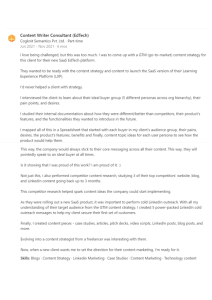I’m here to talk about LinkedIn Experiences that start with:
- “Responsibilities included…”
- “I worked on XYZ…”
- “I helped this client with XYZ…”
- or are left blank!
Boring! This is wasted potential. If you’re looking for your ideal clients on LinkedIn, you must make the most of all available space. There’s mighty space in your Experience section to tell stories that’ll hook, engage, and awe your prospects.
The Experience section on LinkedIn isn’t frequented by passers-by. Only serious prospects are interested in what you’ve been up to throughout your career. Our task today is to help these prospects gain confidence in us and know us better so they become clients who are ready and excited to work with us.
If you have permission from your client to use their name on your website and socials, and if you haven’t signed a non-disclosure agreement with them, add all your clients as separate Experiences on LinkedIn. This way, you can use the available space for better search optimization.
Here’s all the information you can add to your Experiences on LinkedIn:
- Title — Use keywords, such as Freelance B2B Tech Writer or Freelance Content Marketing Writer.
- Type of employment — You can choose either freelance or self-employed here.
- Company name — Find your client on LinkedIn and add them here.
- Location and location type — You can mention your location and whether your job was on-site, remote, or hybrid.
- Duration — Add when you started and ended the engagement.
- Industry — Add the industry you work in plus the words “Marketing” or “Advertising.”
- Description — We’ll work to make this one shine in just a bit.
- Skills — Add up to five skills you used to complete this project.
- Media — Add links to your best samples to feature them in this experience.
Now, we want to make the Description enticing as it’s the meat and potatoes of the experience. What better way than storytelling? Every client you’ve worked with has elevated your skills and made you better at what you do. Every experience has given you a story.
Storytelling Elements for Your LinkedIn Experiences
Humans have employed storytelling since the beginning of time. Did you know that human language evolved because we love to gossip? Why? Because our survival depended on it (read Sapiens by Yuval Noah Harari), on sharing stories about our experiences and about others’ experiences that didn’t work so well for them… This is why our language is descriptive and rich.
Stories strike a nerve and allow us to impactfully communicate ideas. You could say you’re a good freelance writer who helps companies with high-quality content. But it won’t have the same impact as allowing the reader to reach that conclusion after reading a client experience story.
Here’s everything you need to tell a good client story:
- A challenge — Start with a challenge. How did you feel when you landed this project or signed this client? What was the first roadblock you hit? Every challenge you encounter makes a great story. So, think about this client experience. Go back to your email threads to refresh your memory. A challenge can be something you personally struggled with or the client wrestled with… like maybe you felt intimidated by a new client or your client’s content strategy resulted in low blog traffic.
- The stakes — Let’s add some spice to the story. What would’ve happened if you had failed to overcome the roadblock? Would it mean failure for the project? Would it mean changing career directions? Would it mean getting fired? Expand on the situation you were in. Explain why the stakes were high and failure was not an option.
- Your action — How did you overcome the challenge? What skills did you employ? Whose help did you solicit? Did you take a course? Did you try a new approach? Did you work with your client to sort it out? Write down everything you did to address the challenge.
- Your results — Then, talk about what worked out of all the approaches and why. What were you able to achieve for yourself and this client? What did the results look like? If you have specific KPIs to show as results, use them here. But qualitative results are just as effective in completing this story. For example, helping a client publish thought leadership content consistently or increasing brand awareness.
- Your lessons — How do you integrate what you learned on this project into your current work? Did you change your approach? Did your processes change? Did you shift into a new mindset? And how does this matter to your clients? How do you help your clients better now as a result of this experience?
Here’s an example of how I did it on my profile:

A story of your triumph over a challenge says a lot about you as a professional. We all evolve as part of our work life and must tell our stories confidently. Clients who want to partner with someone for the long term will value a person with a growth mindset and a can-do attitude.
Stories make your Experience section stand out in a sea of vanilla LinkedIn profiles. Use them!